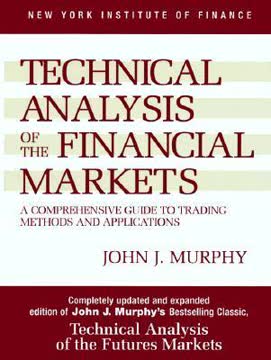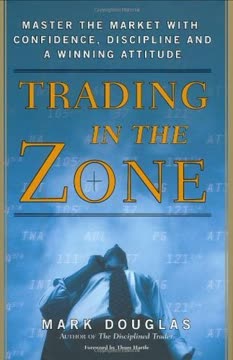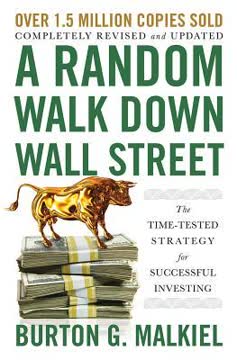Key Takeaways
1. Charts are the footprints of money: Learn to read them
"Charts are the Footprint of Money"
Visual representation of market activity. Charts provide a graphical representation of historical price movements, volume, and other key data points for stocks, indices, or other financial instruments. By learning to read and interpret these charts, investors can gain valuable insights into market sentiment, trends, and potential future price movements.
Technical analysis foundation. Chart reading forms the basis of technical analysis, which assumes that all known information about a security is reflected in its price and trading activity. This approach allows investors to make informed decisions based on historical patterns and current market behavior, rather than relying solely on fundamental analysis or news events.
Key chart components:
- Price bars or candlesticks: Represent opening, closing, high, and low prices for a given time period
- Volume: Indicates the number of shares traded
- Time scale: Shows the duration covered by the chart (e.g., daily, weekly, monthly)
- Trend lines: Connect significant highs or lows to visualize price trends
- Support and resistance levels: Identify areas where prices tend to stall or reverse
2. Understanding market cycles: Accumulation, participation, and distribution
"The three phases of a market cycle recognized by Charles Dow are very apparent in today's market. These phases are a part of every market cycle."
Market cycle phases. Every market cycle consists of three distinct phases: accumulation, participation, and distribution. Understanding these phases helps investors identify opportune times to enter or exit positions.
- Accumulation phase:
- Occurs at market bottoms
- Smart money enters the market
- Prices stabilize and begin to rise
- Participation phase:
- Longest-lasting phase
- Public begins to enter the market
- Prices rise steadily with occasional pullbacks
- Distribution phase:
- Occurs at market tops
- Smart money begins to sell to the public
- Prices become more volatile and struggle to make new highs
Recognizing phase transitions. By observing changes in price action, volume, and market sentiment, investors can identify transitions between phases and adjust their strategies accordingly. This knowledge helps prevent buying at market tops or selling at market bottoms.
3. Support and resistance levels: Key to successful trading
"Entry and exit points are vital parts of trading and investing."
Price action boundaries. Support and resistance levels represent price points where a security has historically had difficulty moving beyond. Support levels are prices where buying interest has been strong enough to prevent further declines, while resistance levels are prices where selling pressure has been sufficient to halt advances.
Trading strategies:
- Buy near support levels
- Sell near resistance levels
- Wait for breakouts or breakdowns for confirmation
Role reversal. When a support or resistance level is breached, it often reverses its role. Former support becomes new resistance, and former resistance becomes new support. This phenomenon provides traders with additional entry and exit opportunities.
Identifying levels:
- Previous highs and lows
- Round numbers (e.g., $50, $100)
- Moving averages
- Trend lines
- Fibonacci retracements
4. Candlestick patterns: Visual cues for market sentiment
"Candlesticks form based solely on the price movement and many of the candles are very telling."
Quick visual analysis. Candlestick charts provide a wealth of information about price action and market sentiment in an easy-to-read format. Each candlestick represents a specific time period and shows the opening, closing, high, and low prices for that period.
Common candlestick patterns:
- Doji: Indecision in the market
- Hammer: Potential reversal at market bottoms
- Shooting Star: Potential reversal at market tops
- Engulfing patterns: Strong shift in sentiment
- Harami: Potential trend reversal
Pattern interpretation. Candlestick patterns often signal potential reversals or continuations of trends. By recognizing these patterns, traders can anticipate potential price movements and make more informed decisions about entry and exit points.
5. Moving averages: Smoothing out price action to spot trends
"Moving averages are extremely popular with market technicians and for good reason. Moving averages smooth out the price action and make it easier to spot the underlying trends."
Trend identification. Moving averages help identify and confirm trends by smoothing out short-term price fluctuations. They provide a clearer picture of the overall price direction, making it easier for traders to determine whether a security is in an uptrend, downtrend, or trading sideways.
Popular moving averages:
- 50-day moving average: Short-term trend
- 200-day moving average: Long-term trend
Trading strategies:
- Crossovers: Buy when shorter-term MA crosses above longer-term MA, sell when it crosses below
- Support/Resistance: Use MAs as dynamic support or resistance levels
- Trend confirmation: Trade in the direction of the moving average slope
Golden and Death Crosses. When the 50-day moving average crosses above the 200-day moving average, it's called a Golden Cross and is considered bullish. The opposite, a Death Cross, occurs when the 50-day MA crosses below the 200-day MA and is considered bearish.
6. Volume: The great confirmer of price movements
"Volume tells us a story too. It's like the Great Confirmer."
Validation of price action. Volume is a crucial component of technical analysis, as it provides confirmation of price movements and helps validate the strength of trends. High volume accompanying a price move suggests strong conviction, while low volume may indicate a lack of enthusiasm or sustainability.
Volume characteristics:
- Increasing volume during uptrends: Confirms bullish sentiment
- Decreasing volume during downtrends: Confirms bearish sentiment
- Divergence between price and volume: Potential trend reversal signal
Interpreting volume patterns:
- Volume spikes: Potential exhaustion or capitulation
- Declining volume during consolidation: Potential breakout preparation
- Volume preceding breakouts: Higher volume suggests a more reliable breakout
Volume and chart patterns. Volume plays a crucial role in confirming chart patterns, such as Head and Shoulders, Double Tops/Bottoms, and Triangle patterns. Strong volume on breakouts from these patterns increases the likelihood of successful trades.
7. Stop losses: Essential for protecting your capital
"To be a successful investor you must decide on your investing objectives, and then get a strategy that will work for you, and most importantly, establish rules for limiting your losses that you will adhere to."
Capital preservation. Stop losses are crucial for protecting investment capital by automatically closing out positions when they move against you. They help limit potential losses and remove emotional decision-making during market downturns.
Types of stop losses:
- Fixed stop loss: Set at a specific price level
- Percentage stop loss: Set at a percentage below the entry price
- Trailing stop loss: Moves up as the price increases, locking in profits
Implementing stop losses:
- Place stop loss orders immediately after entering a position
- Set stop losses based on technical levels (e.g., below support)
- Avoid setting stops too close to current price to prevent premature exits
- Regularly review and adjust stop levels as the trade progresses
Psychological benefits. Stop losses provide peace of mind by defining the maximum potential loss before entering a trade. This allows traders to focus on identifying opportunities rather than worrying about potential losses.
8. Risk vs. reward: The foundation of every trading decision
"Always think risk vs. reward when entering any trade or investment."
Rational decision-making. The risk-reward ratio is a fundamental concept in trading and investing that helps determine whether a potential trade is worth taking. It compares the potential profit of a trade to its potential loss, allowing traders to make more informed decisions.
Calculating risk-reward:
- Identify potential entry point
- Determine stop loss level (risk)
- Identify profit target (reward)
- Calculate ratio: (Potential Reward) / (Potential Risk)
Favorable ratios. Generally, traders aim for risk-reward ratios of at least 1:2 or higher, meaning the potential reward is at least twice the potential risk. This approach allows for profitability even if only a fraction of trades are successful.
Application to trading:
- Avoid trades with unfavorable risk-reward ratios
- Seek high-probability setups with strong risk-reward profiles
- Use technical analysis to identify optimal entry points, stop losses, and profit targets
9. Trend lines and chart patterns: Forecasting future price movements
"Trend lines are straight lines that are drawn parallel to basic trend lines. A rising channel line would be drawn above the price action and parallel to the basic trend line (which is below the price action) connecting the 'highs' that the stock has reached."
Visual trend analysis. Trend lines and chart patterns help traders identify and forecast potential price movements. By connecting significant highs or lows, trend lines provide a visual representation of the current trend and potential support or resistance levels.
Common chart patterns:
- Head and Shoulders: Potential trend reversal
- Double Tops/Bottoms: Potential trend reversal
- Triangles: Potential continuation or reversal
- Flags and Pennants: Short-term continuation patterns
Trading strategies:
- Buy at support of upward trend lines
- Sell at resistance of downward trend lines
- Look for breakouts from chart patterns for entry signals
- Use pattern completion as profit targets
Pattern reliability. The more times a trend line or pattern is tested, the more significant it becomes. However, always wait for confirmation (e.g., breakout, increased volume) before acting on a pattern.
10. Entry and exit points: Timing is everything in the stock market
"The precise timing of entry and exit points is an indispensable aspect of any trade, short term or long term."
Crucial decision points. Proper timing of entry and exit points can significantly impact trading profitability. Entering too early or exiting too late can turn potential winners into losers, while entering too late or exiting too early can limit potential gains.
Entry strategies:
- Buy at support levels or during pullbacks in uptrends
- Enter after confirmation of trend reversals
- Use breakouts from chart patterns as entry signals
- Wait for high-probability setups with favorable risk-reward ratios
Exit strategies:
- Take profits at resistance levels or price targets
- Use trailing stop losses to lock in gains
- Exit when chart patterns or indicators suggest trend reversal
- Implement time-based exits for short-term trades
Psychological aspects. Develop a disciplined approach to entries and exits to avoid emotional decision-making. Stick to your trading plan and avoid the temptation to chase trades or hold onto losing positions.
Last updated:
FAQ
What's "Charting and Technical Analysis" by Fred McAllen about?
- Investment Mistakes: The book focuses on how investment mistakes often stem from buying the wrong investment or buying at the wrong time.
- Market Trends: It emphasizes understanding market trends and cycles, highlighting the importance of timing in investments.
- Technical Analysis: The book introduces readers to technical analysis and charting as tools to make informed investment decisions.
- Avoiding Losses: It aims to educate investors on avoiding losses by recognizing market tops and bottoms through chart patterns and technical indicators.
Why should I read "Charting and Technical Analysis" by Fred McAllen?
- Informed Decisions: The book equips readers with the knowledge to make informed investment decisions using technical analysis.
- Avoiding Common Pitfalls: It helps investors avoid common pitfalls like buying at market tops or holding onto losing investments.
- Practical Tools: Readers gain practical tools and strategies for analyzing market trends and patterns.
- Empowerment: The book empowers investors to take control of their financial future without relying solely on financial advisors.
What are the key takeaways of "Charting and Technical Analysis" by Fred McAllen?
- Market Cycles: Understanding market cycles and trends is crucial for successful investing.
- Technical Tools: Utilize technical analysis tools like moving averages, trend lines, and chart patterns to predict market movements.
- Risk Management: Implement stop losses and trailing stops to protect investment capital.
- Informed Trading: Make decisions based on chart patterns and volume rather than emotions or market hype.
How does Fred McAllen define technical analysis in "Charting and Technical Analysis"?
- Price and Volume Focus: Technical analysis focuses on price movements and trading volume to predict future market behavior.
- Chart Patterns: It involves identifying chart patterns that indicate potential market reversals or continuations.
- Market Psychology: Technical analysis considers market psychology and investor behavior as reflected in price charts.
- Objective Analysis: It provides an objective method for analyzing market trends without relying on subjective opinions or news.
What are the best quotes from "Charting and Technical Analysis" by Fred McAllen and what do they mean?
- "Charts are the Footprint of Money": This quote emphasizes that charts reflect the actual flow of money in the market, providing a reliable basis for analysis.
- "The time to buy is when there’s blood in the streets": This suggests that the best buying opportunities often arise during market downturns when prices are low.
- "All ships rise and fall with the tide": It highlights the interconnectedness of individual stocks with the overall market trend.
- "Nothing ever changes": This quote by Jesse Livermore, referenced in the book, underscores the repetitive nature of market cycles and patterns.
How does Fred McAllen suggest using moving averages in "Charting and Technical Analysis"?
- Trend Identification: Moving averages help identify the overall trend direction by smoothing out price fluctuations.
- Support and Resistance: They can act as dynamic support and resistance levels, indicating potential reversal points.
- Buy/Sell Signals: Crossovers of different moving averages can signal potential buy or sell opportunities.
- Long-term Analysis: The 200-day moving average is particularly useful for long-term trend analysis and investment decisions.
What is the "Buy and Hold" theory according to Fred McAllen in "Charting and Technical Analysis"?
- Long-term Strategy: The "Buy and Hold" theory suggests holding investments for the long term to ride out market fluctuations.
- Market Cycles: McAllen argues that this strategy can be risky if not timed correctly with market cycles.
- Historical Returns: While historically stocks have averaged a 10% annual return, the timing of entry and exit is crucial.
- Market Tops: The theory can lead to significant losses if investments are made at market tops without considering technical analysis.
How does Fred McAllen describe the role of financial advisors in "Charting and Technical Analysis"?
- Sales Focus: McAllen criticizes modern financial advisors for being more focused on sales than on providing sound investment advice.
- Lack of Experience: He highlights that many advisors lack the necessary experience and knowledge to make informed investment decisions.
- Commission-driven: Advisors may push products that offer higher commissions rather than those that are in the best interest of the client.
- Investor Empowerment: The book encourages investors to take control of their financial decisions rather than relying solely on advisors.
What are the "Three Phases of Primary Trends" in "Charting and Technical Analysis" by Fred McAllen?
- Accumulation Phase: This phase occurs after a market decline when informed investors start buying undervalued stocks.
- Public Participation Phase: As the market trend becomes apparent, more investors join in, driving prices higher.
- Distribution Phase: Informed investors begin selling their holdings to less informed investors, often leading to a market top.
- Market Cycle: Understanding these phases helps investors identify potential entry and exit points in the market.
How does Fred McAllen explain the importance of stop losses in "Charting and Technical Analysis"?
- Risk Limitation: Stop losses are crucial for limiting potential losses on investments.
- Automatic Execution: They automatically sell a security when it reaches a predetermined price, protecting against further declines.
- Discipline: Using stop losses instills discipline in trading by preventing emotional decision-making.
- Capital Preservation: They help preserve investment capital, allowing investors to re-enter the market at more favorable conditions.
What are the "Reversal Patterns" discussed in "Charting and Technical Analysis" by Fred McAllen?
- Head and Shoulders: This pattern indicates a potential reversal of an uptrend, signaling a bearish market.
- Double Tops and Bottoms: These patterns suggest a reversal of the current trend, either bullish or bearish.
- Candlestick Patterns: Patterns like the Doji, Hammer, and Engulfing candles provide early warnings of trend reversals.
- Volume Confirmation: Reversal patterns are more reliable when confirmed by changes in trading volume.
How does Fred McAllen suggest using chart patterns in "Charting and Technical Analysis"?
- Pattern Recognition: Identify common chart patterns like triangles, flags, and pennants to predict market movements.
- Continuation Patterns: Use patterns like symmetrical triangles to anticipate the continuation of the current trend.
- Entry and Exit Points: Chart patterns help determine optimal entry and exit points for trades.
- Volume Analysis: Confirm patterns with volume analysis to ensure the reliability of the predicted trend.
Review Summary
Charting and Technical Analysis receives high praise for its clear explanations of technical analysis fundamentals. Readers appreciate the concise writing, practical examples, and focus on risk management. Many find it an excellent resource for beginners, offering insights into chart patterns, trends, and market psychology. The book's simplicity and straightforward approach make complex concepts accessible. Some readers note its limitations for advanced traders but consider it a valuable starting point. Overall, it's highly recommended for those seeking to understand technical analysis basics and improve their trading skills.
Similar Books










Download PDF
Download EPUB
.epub digital book format is ideal for reading ebooks on phones, tablets, and e-readers.





